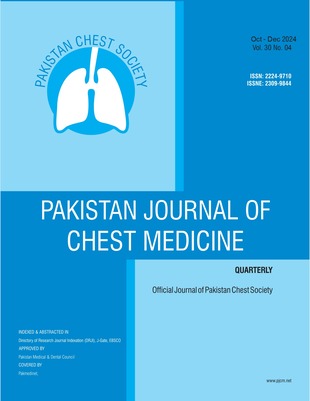Radiologic Patterns of Thickened Pleura in Infective vs. Non-Infective Causes
Keywords:
Pleural Thickening, Infective Pleural Disease, Non-Infective Pleural Disease, Computed Tomography (CT)Abstract
 Background: Pleural thickening is a radiologic finding with various infectious and non-infectious origins. It is important to tell these conditions apart for an accurate diagnosis. This helps ensure proper treatment, especially in areas with high tuberculosis and asbestos exposure. Objective: This study aims to analyze CT imaging characteristics of infective and non-infective pleural thickening and evaluate their diagnostic utility. Methods: A retrospective study was conducted at Lady Reading Hospital, Peshawar, involving 200 patients diagnosed with pleural thickening over a one-year period. CT scans were assessed for pleural thickness, distribution, enhancement characteristics, and associated findings. Results: Among infective cases (n=97), unilateral involvement was seen in 85.6%, with smooth enhancement (74.2%) and pleural effusion (71.1%). Non-infective cases (n=103) more frequently displayed bilateral thickening (37.9%), nodular enhancement (54.4%), and calcifications (31.1%). Multivariate analysis identified nodular enhancement and subpleural nodularity as key indicators of non-infective causes. Conclusion: CT imaging provides critical insights for differentiating between infective and non-infective pleural thickening. Identifying characteristic imaging features enhances diagnostic accuracy and facilitates early intervention for better patient outcomes ÂReferences
References
1. Hallifax RJ, Talwar A, Wrightson JM, Edey A, Gleeson FV. State-of-the-art: Radiological investigation of pleural disease. Respir Med. 2017;124:88-99.
Yamada A, Taiji R, Nishimoto Y, Itoh T, Marugami A, Yamauchi S, et al. Pictorial review of pleural disease: Multimodality imaging and differential diagnosis. Radiographics. 2024;44(4):e230079.
Qureshi NR, Gleeson FV. Imaging of pleural disease. Clin Chest Med. 2006;27(2):193-213.
Hassan M, Touman AA, Grabczak EM, Skaarup SH, Faber K, Blyth KG, et al. Imaging of pleural disease. Breathe (Sheff). 2024;20(1):230172.
Koegelenberg CF, Diacon AH. Image-guided pleural biopsy. Curr Opin Pulm Med. 2013;19(4):368-73.
Metintas M, Ak G, Metintas S, Yildirim H, Dündar E, Rahman N. Prospective study of the utility of computed tomography triage of pleural biopsy strategies in patients with pleural diseases. J Bronchology Interv Pulmonol. 2019;26(3):210-8.
Usuda K, Iwai S, Funasaki A, Sekimura A, Motono N, Matoba M, et al. Diffusion-weighted imaging can differentiate between malignant and benign pleural diseases. Cancers (Basel). 2019;11(6):E811.
Walker S, Bibby AC, Maskell NA. Current best practice in the evaluation and management of malignant pleural effusions. Ther Adv Respir Dis. 2017;11(2):105-14.
Evans AL, Gleeson FV. Radiology in pleural disease: state of the art. Respirology. 2004;9(3):300-12.
Roach HD, Davies GJ, Attanoos R, Crane M, Adams H, Phillips S. Asbestos: when the dust settles—an imaging review of asbestos-related disease. Radiographics. 2002;22(Spec No):S167-84.
Qureshi NR, Rahman NM, Gleeson FV. Thoracic ultrasound in the diagnosis of malignant pleural effusion. Thorax. 2009;64(2):139-43.
Caceres JD, Venkata AN. Asbestos-associated pulmonary disease. Curr Opin Pulm Med. 2023;29(2):76-82.
Escalon JG, Harrington KA, Plodkowski AJ, Zheng J, Capanu M, Zauderer MG, et al. Malignant pleural mesothelioma: are there imaging characteristics associated with different histologic subtypes on computed tomography? J Comput Assist Tomogr. 2018;42(4):601-6.
Traill ZC, Davies RJ, Gleeson FV. Thoracic computed tomography in patients with suspected malignant pleural effusions. Clin Radiol. 2001;56(3):193-6.
Yilmaz U, Polat G, Sahin N, Soy O, Gülay U. CT in differential diagnosis of benign and malignant pleural disease. Monaldi Arch Chest Dis. 2005;63(1):17-22.
Hooper C, Lee YC, Maskell N. Investigation of a unilateral pleural effusion in adults: British Thoracic Society Pleural Disease Guideline 2010. Thorax. 2010;65(Suppl 2):ii4-17.
Froudarakis ME. Pleural effusion in lung cancer: more questions than answers. Respiration. 2012;83(5):367-76.
Korczynski P, Krenke R, Safianowska A, Gorska K, Abou Chaz MB, Maskey-Warzechowska M, et al. Diagnostic utility of pleural fluid and serum markers in differentiation between malignant and non-malignant pleural effusions. Eur J Med Res. 2009;14(Suppl 4):128-33.
Frank AL, Joshi TK. The global spread of asbestos. Ann Glob Health. 2014;80(4):257-62.
Aluja Jaramillo F, Gutierrez F, Bhalla S. Pleural tumours and tumour-like lesions. Clin Radiol. 2018;73(12):1014-24.
Downloads
Published
How to Cite
Issue
Section
License
Copyright (c) 2024 Pakistan Journal of Chest Medicine

This work is licensed under a Creative Commons Attribution-NonCommercial 4.0 International License.








